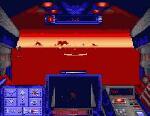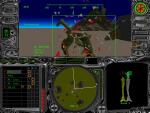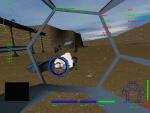Older than Old School: MechWarrior
 Dynamix
started out as an independent development house. They’d done
a variety of tank-based games in the 80’s – Arctic Fox
for Electronic Arts; Stellar 7 and Nova 9 for Sierra. They hit
the jackpot with MechWarrior, published by Activision in 1989.
For the first time, PC gamers actually were able to “sit
inside” their ‘Mechs. Play was relatively simple, as
were the EGA graphics, but, in many ways, the depth of the first
MechWarrior has not been touched. The action took place pretty
much wherever the player chose, with location being important
to ‘Mech design (icy planets were everyone’s favorites
– no heat!). There was also some additional role-playing
that took place outside of the ‘Mech. MechWarrior really
isn’t worth playing any more, but it certainly provides a
benchmark for robot sims.
Dynamix
started out as an independent development house. They’d done
a variety of tank-based games in the 80’s – Arctic Fox
for Electronic Arts; Stellar 7 and Nova 9 for Sierra. They hit
the jackpot with MechWarrior, published by Activision in 1989.
For the first time, PC gamers actually were able to “sit
inside” their ‘Mechs. Play was relatively simple, as
were the EGA graphics, but, in many ways, the depth of the first
MechWarrior has not been touched. The action took place pretty
much wherever the player chose, with location being important
to ‘Mech design (icy planets were everyone’s favorites
– no heat!). There was also some additional role-playing
that took place outside of the ‘Mech. MechWarrior really
isn’t worth playing any more, but it certainly provides a
benchmark for robot sims.
 As
a side note, the online-gaming company Kesmai licensed the original
MechWarrior engine, and created Multi-Player Battletech. It appeared
on the one of the pre-Internet network giants, GEnie. Once again,
the primitive graphics of that first simulation proved to be less
important to die-hard ‘Mech jockeys than the rich world they
created around it. Multi-Player Battletech, using an updated (if
still somewhat antiquated) engine, is still available from Kesmai.
As
a side note, the online-gaming company Kesmai licensed the original
MechWarrior engine, and created Multi-Player Battletech. It appeared
on the one of the pre-Internet network giants, GEnie. Once again,
the primitive graphics of that first simulation proved to be less
important to die-hard ‘Mech jockeys than the rich world they
created around it. Multi-Player Battletech, using an updated (if
still somewhat antiquated) engine, is still available from Kesmai.
The Engine that Would Not Die: MechWarrior
2 and Friends
A quick quiz: what do the following games have in common?
MechWarrior 2, MechWarrior 2: Ghost Bear’s Legacy, MechWarrior:
Mercenaries, MechWarrior 2:Titanium Trilogy, Interstate ’76
(Nitro AND Gold Editions), Heavy Gear, and Battlezone?
 Simple.
They all share the same engine – created in 1995 by a team
working under Activision. This was the engine created for MechWarrior
2. The game had a very difficult birth – it was over a year
late (a big deal at the time), and had more than one development
team – the first team had been fired. The wait, however,
had been worth it. MechWarrior 2was a rich, deep simulation of
‘Mech combat. The graphics were extremely good for their
time, pushing the machines of the mid-90’s era to the limit.
It did have a few flaws – the “Circle of Death”
was introduced, and has been plaguing ‘Mech games ever since;
weapons were unbalanced and could be abused (nothing could stop
a medium-laser and two-LRM-20 Mad Cat); multiplayer was flaky
at best. The mission structure was also very fixed, and, since
you were playing on the side of the resource-rich clans, salvage
was not an issue.
Simple.
They all share the same engine – created in 1995 by a team
working under Activision. This was the engine created for MechWarrior
2. The game had a very difficult birth – it was over a year
late (a big deal at the time), and had more than one development
team – the first team had been fired. The wait, however,
had been worth it. MechWarrior 2was a rich, deep simulation of
‘Mech combat. The graphics were extremely good for their
time, pushing the machines of the mid-90’s era to the limit.
It did have a few flaws – the “Circle of Death”
was introduced, and has been plaguing ‘Mech games ever since;
weapons were unbalanced and could be abused (nothing could stop
a medium-laser and two-LRM-20 Mad Cat); multiplayer was flaky
at best. The mission structure was also very fixed, and, since
you were playing on the side of the resource-rich clans, salvage
was not an issue.
All of this changed – or should have changed, in the MechWarrior
2 sequel, Mercenaries (1996). Looking back, Mercenaries is the
real benchmark for ‘Mech games. In it, the player took on
the part of a mercenary lance commander, with the freedoms and
responsibilities thereof. It featured relatively free-form play
(random missions build around a central plot), proper salvage
and economic rules, lots of ‘Mechs, a complete ‘Mech
building system, textured-polygon graphics (!), and Windows-based
multiplayer. It was just too bad that, on release, very little
of what made Mercenaries interesting worked! A year passed before
Mercenaries settled down to become the game it was originally
promised to be. The final V1.08 patch provided completely revamped
salvage rules, fixed multiplayer, and had complete Direct3D graphics.
The Titanium Trilogy contained the Direct3D ports of both MechWarrior
2 games, as well as the Ghost Bear expansion. Despite somewhat
dated graphics that are fixed at 640x480 (making it perfect full-screen
anti-aliasing fodder on a V5 card), it’s modern enough to
still be worth playing. There are still enough Titaniums out there
in bargain bins to make the purchase relatively easy.